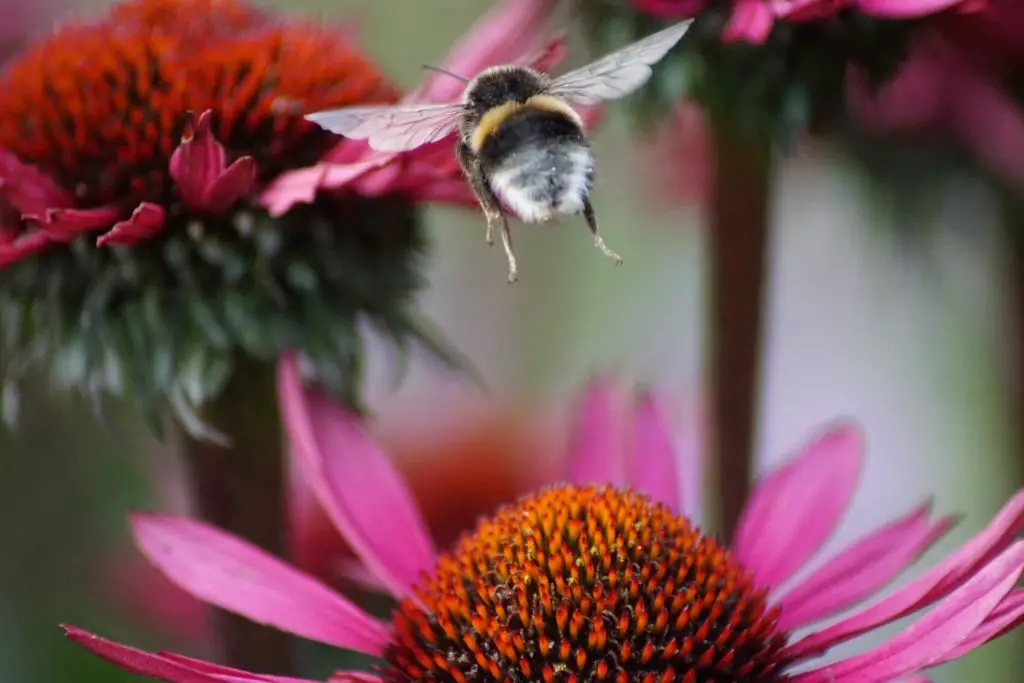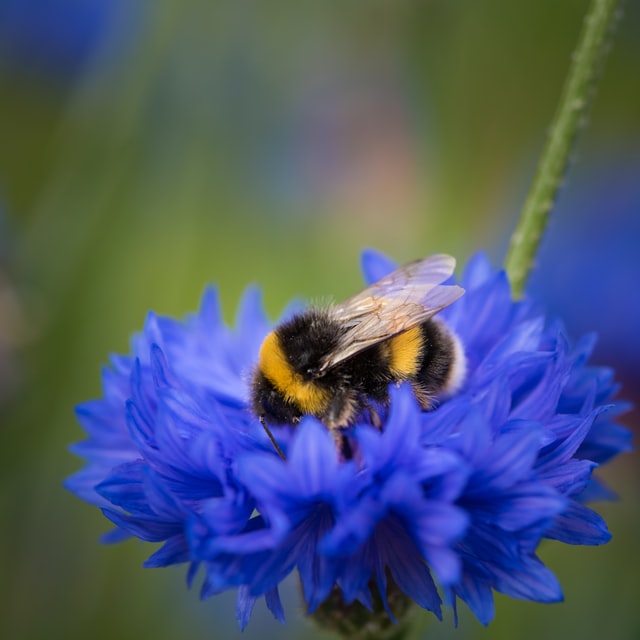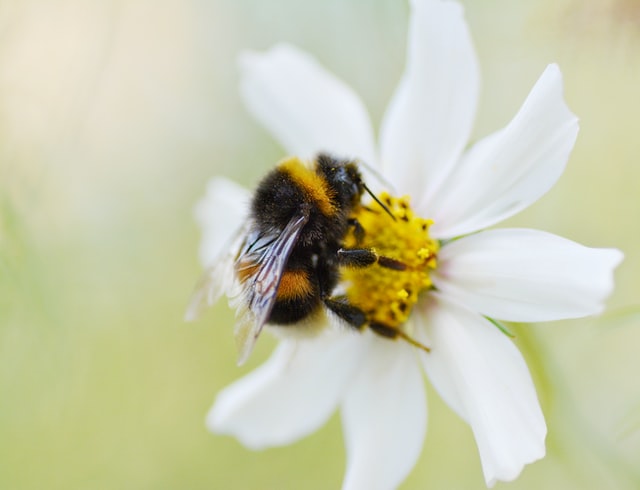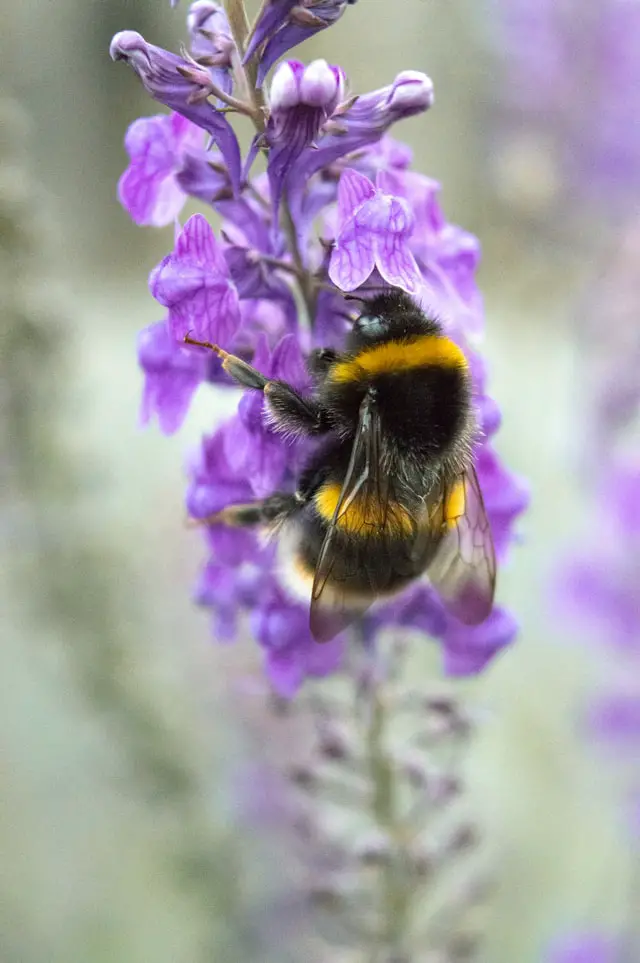Last updated on September 21st, 2023 at 12:06 pm
The White-tailed bumblebee, Latin name Bombus lucorum is a species of bumblebee common across the United Kingdom and Europe. The term White-tailed bumblebee is a cover-all for three species of bumblebee with nearly indistinguishable characteristics.
These three taxa are:
- B. lucorum – White-tailed bumblebee
- Bombus magnus – Northern white-tailed bumblebee
- Bombus cryptarum – Cryptic bumblebee
At a higher level, Bombus lucorum is part of the order Hymenoptera, along with wasps and ants and the Apidae family which comprises all known bee species.
What do White-Tailed Bumblebees look like?
Other than the Western honeybee, the White-tailed bumblebee may be the most recognisable and well-known bee species in the Western hemisphere. It bears the classic yellow band located at the top of the thorax with another band displayed halfway down the abdomen as shown in the pictures below.
The most defining characteristic is the pure white tail or bum found at the rear of the bumblebee. Some males of the species may display yellow-coloured facial hair and can display yellowing across their whole body with the most yellow hairs found on the thorax.
What do White-Tailed Bumblebees queens look like?
Queens of the Bombus lacorum species are significantly bigger than the workers, approximately 50% with the males of the species approximately 30% larger than the female workers.
It can be very hard to identify different species of queen bumblebee due to their very similar characteristics but there are some small signs you can look for. Queens belonging to the Northern white-tailed bumblebee have a considerably extended collar when compared to queens belonging to the White-tailed bumblebee taxa and Cryptic queens displaying s-shaped black markings through their wing bases and collar.
How big is a White-Tailed Bumblebee?
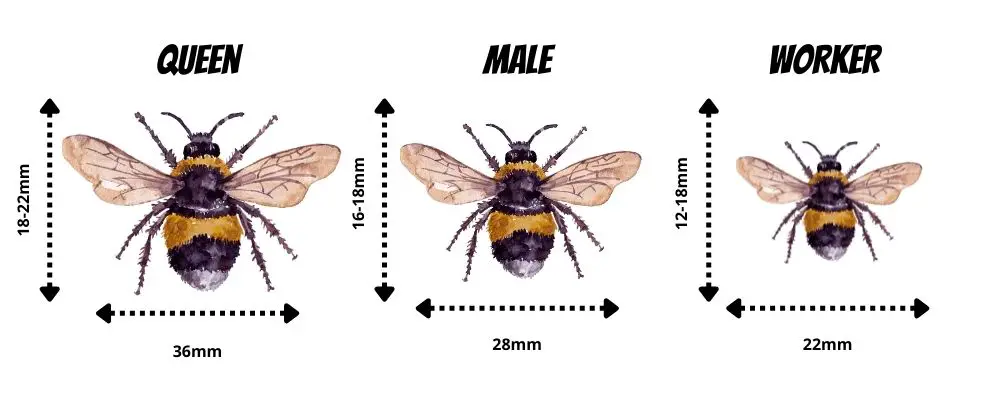
Approximate sizes of the different castes are as follows:
- Queens – Wingspan 36mm/ Height 18-22mm/ Weight 0.46-0.70g
- Males –Wingspan 28mm/ Height 16-18mm/Weight 0.06-0.45g
- Workers –Wingspan 22mm/ Height 12-18mm/Weight 0.04-0.32g
How do you tell the difference between a bumblebee and a white-tailed bumblebee?
The easiest way to identify if you’re observing a White-tailed bumblebee is the pure white patch at the rear of the bee and two distinct yellow collars on the abdomen and thorax. Identifying which of the three taxa is very hard without actually testing the DNA of the bee.
Want to learn more about the fascinating world of bumblebees? Check out our detailed guide on the early bumblebee to find out about the early riser of the bumblebee world.
How do White-Tailed Bumblebees build their nests?
After the queen has found a suitable location to start building her nest, she begins by building a large wax pot (wax to create the honey pot is excreted from between segments of the queen’s abdomen) to store honey and regurgitates some of the nectar she’s collected, filling the pot.
The pollen stores she’s collected are partially consumed for energy and the remainder is combined with saliva and nectar to make a form of ‘bee bread’ that acts as a food store for consecutive days of bad weather and no foraging flights. It’s believed that combining pollen with the queen’s saliva acts to prolong the shelf life of the pollen and prevent bacteria growth and spoiling.
Later the pollen will be used as a base for laying eggs and brooding so the queen will naturally place the wax honey pot in easy to reach location where she can feed without needing to move from her vulnerable eggs.
White-Tailed Bumblebee lifecycle
White-tailed bumblebees operate on a yearly cycle, emerging, building a nest, raising young, foraging, mating and then hibernating again.
This process begins when new queens appear from their soil burrows in early spring (late March to early April) to start building their colony.
All the reserves stored up by the queen for winter are completely depleted and regaining her energy is paramount. New queens will set out to find suitable flowers to feast on.
During the early stages of her lifecycle, the young queen will consume pollen and nectar to allow her to grow and develop. Pollen in particular provides her with all the nutrients she needs to develop her ovaries in preparation for raising young.
This period of forage typically lasts a few weeks before the queen’s instincts compel her to take flight and find a suitable location to start building her nest.
Once the queen has taken up residence she will begin to raise her first set of young worker bees. The queen will lay eggs onto the large pollen store in batches of 4-16 eggs and cover them in a layer of wax. These eggs are tiny in size at approximately 3mm in length
Queens will brood their eggs by positioning their abdomen directly above the eggs, their primarily hairy bodies have a bare patch directly at the bottom of their abdomen to allow them to transfer body heat directly into the young larvae. The aim here is to keep the temperature of the eggs consistently above 30oC.
During this period the queen will take very short trips to forage to avoid the eggs getting too cold and after around 4 days the eggs will begin to hatch. When the larvae hatch they begin to consume the pollen stores and pupate to become mature female adults ready to begin foraging for nectar and pollen.
At this early stage, the queen will only produce fertilised eggs becoming female workers. As the season draws to a close she will begin to create unfertilised males to mate with new queens and some of the fertilised eggs will start to be fed more regularly. This increase in feeding encourages females to start to become virgin queens ready for their mating flight.
It’s believed that the current queen is responsible for releasing a pheromone that stops the production of new queens. As the season draws to an end her ability to produce this pheromone decreases, signalling other bees in the nest to increase their feeding schedule.
How do they collect nectar?
White-tailed bumblebees are equipped with some of the shortest tounges of the bumblebee family, despite this apparent handicap they have developed an ingenious method of extracting the nectar they need from flowers.
‘Nectar robbing’ is a technique developed to allow White-tails to access nectar they would otherwise be unable to reach with their tounges. They utilise a horny sheath that surrounds their tongue to cut an incision into the lower part of the petal, the hole they create is then used to insert their tongue through and reach nectar contained deep within the flower.
Where do they build their nests?
As a queen consumes pollen and nectar in early spring her ovaries begin to swell signalling she is ready to begin making a nest. Queens will typically seek out old rodent nests, holes in brickwork and the base of overgrown hedgerows for potential nest sites.
Queens are often sighted investigating nooks and crannies within your house during this period and will forgo foraging in favour of seeking out a suitable home for their new colony. If a queen is unable to find a suitable nest site during this period she will slowly stave to death.
Suitable habitat
You can find colonies of White-Tailed bumblebees all over the country, and some of the most common areas for sightings include:
- Towns and urban areas
- Gardens
- Farmland
- Meadows
- Woodlands
- Coastal areas
- Moorland
- Wetlands
Are White-tailed bumblebees aggressive?
No, typically White-tailed bumblebees are only ever aggressive if threatened and are less aggressive than other species like honeybees.
As with all bees, observe from a distance and don’t do anything that may be considered threatening like swatting and you’ll be absolutely fine.
Are White-tailed bumblebees rare?
No, White-tailed bumblebees are very common in. the UK and can be seen as early as March in some areas.
Are White-tailed bumblebees native to the UK?
Yes, White-tailed bumblebees are native to the UK and are commonly found all across the country, particularly in the lowlands. The north and west of the Uk are considered to hold the highest populations of White-tailed bumblebees.

